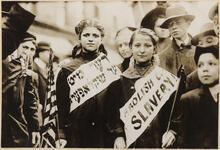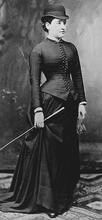Leike Kogan
Born in Swienciany, near Vilnius, Leike Kogan became affiliated with the Bund as a teenager. She fell in love with Samuel Kogan (Tzalel Blitz); both were linked to the Communist Party and had to go into exile in France, where they studied at the University of Toulouse. In 1935 they immigrated to South America, first to Brazil and then Argentina. After working in rural areas, they settled permanently in Buenos Aires and had two children. Leike stood out as the leader of the Yiddisher Kultur Farband (YKUF orICUF) Women's Organization (created in 1947). Throughout her life she worked as a teacher in the ICUF schools. Her commitment to organizations in favor of peace, women's rights, and socialism was reflected in the remarkable magazine Di idishe froi, among others.
Early Life & Family
Lía Gilinski de Kogan, better known as Leike Kogan, was born on October 10, 1911, into a humble family in Swienciany, a village 84 kilometers north of the city of Vilnius. Her parents were Shlomo Leib and Sara Guitel (née Katz) Gilisnky. Because of Vilnius’s large Jewish population, several people called this town on the border with Poland "the Jerusalem of Lithuania." At the time, Swienciany had about 6000 inhabitants and was in the Pale of Settlement, the part of the Russian Empire in which Jews were allowed to live. Leike’s father managed the property of a landowner and the family economy depended on the homemade manufacture of butter that they sold to their neighbors.
When World War I broke out, Leike was six years old. She and her siblings Shaike, Jaime, Jaie Gnesken, and Frida, the oldest nine years old and the youngest a baby, faced a dramatic situation. While their father was sent to the front lines, their mother became ill and was hospitalized in the city of Berlin. Over the course of endless months, the children were left alone. In 1918, when the war ended, the parents managed to return home.
Education
After the war, the village of Swienciany was incorporated into newly independent Poland. Very soon, due to the active work of the General Jewish Workers Party, or the Bund, progressive Yiddish schools began to operate, as well as cultural centers and libraries. Despite post-war misery, the family prioritized the education of Leike and her siblings. Her father was unable to work because of his health, and her mother rented rooms out to help pay for the children’s studies.
In the early 1920s, for the first time the Gilinski children attended traditional Lit. "room." Old-style Jewish elementary school.heder in the morning and secular progressive Jewish shule in the afternoon. In 1926, when Leike was fifteen years old, she attended a gymnasium (high school) in the morning and spent her afternoons reading in the Bund library. There, she also helped younger children with their homework for free and began to take an interest in Marxist theory. While participating in a school event dedicated to the writer David Bergelson, Leike fell in love with a classmate who spoke about the writer. That was Samuel Iser Kogan, who would later become her husband and a well-known intellectual, known by his pseudonym, Tzalel Blitz.
Like so many other young people of their generation, Leike and Samuel were interested in Bolshevik revolutionary culture and experience. But in order to continue their university studies, they had to leave Swienciany. In 1928, the unmarried couple moved to Warsaw, to the disapproval of their families and neighbors. Leike was seventeen and Samuel nineteen. While in Warsaw, Leike and Samuel learned that their names were on the Polish police’s list of "dangerous communists." Anti-Semitic and anti-communist demonstrations forced them to leave. In 1929, with the help of their families, they were able to reach France and settled in the city of Toulouse.
With a remarkable capacity for study, Samuel graduated as an agronomist engineer and obtained a research post at the University of Toulouse, while Leike studied at the École Supérieure de Commerce de l'Etat (Graduate School of Business). In 1930 Samuel was forced to return to Poland to perform military service. and Leike moved to Paris, where she lived with Polish comrades, studied History and Literature at the Sorbonne, and did accounting work and translations from German and French to pay her expenses. In her memoirs she wrote: "[I]n Paris, the essence of our lives were conferences, historical visits, courses, art exhibitions and travel (...) money served only to subsist, but that did not interest us (...) passions were not material, but cultural." While Leike was in Paris, they began to discuss the drawbacks of not being married; Leike knew society disapproved and feared they were not being hired for jobs because of their unmarried status. Samuel, however, believed marriage was an archaic practice.
The great depression of the 1930s produced growing demonstrations of the extreme nationalist right against foreigners and the Parisian atmosphere became hostile. In 1935 Leike planned to travel to Swienciany to meet and marry Samuel and travel together to Birobidzhan. Birobidzhan had been established by Stalin in 1931 in the far east of the country as an autonomous Jewish region, with the aim of sending all Jews in the Soviety Union to live there. A month before leaving, however, an inexplicable telegram arrived denying their request to join the USSR. They decided instead to follow Leike’s brother to Brazil, where he had been living since 1927 and offered Samuel a job on a coffee plantation. Leike and Samuel married only to travel to Brazil, but they always celebrated the day they began their relationship as their anniversary.
Arrival in South America
Leike and Samuel arrived in São Paulo in 1935, but because of the frustrated communist uprising led by Luis Carlos Prestes in November of that year, the Getulio Vargas government restricted jobs for immigrants. Nevertheless, the couple was safe in South America, far from the horror that was looming in their homeland, where their family would be tragically exterminated by Nazism.
In 1936, Samuel found a job as an administrator of the agrarian colonies of the Jewish Colonization Association in Villa Domínguez, Entre Ríos, Argentina. The couple moved to a small, dark house in the countryside, and Leike began to study the Spanish language. Their three children were born in Argentina: Marga, in 1937, who fell ill with diphtheria and died at the age of seven; Máximo, in 1940; and Mirta, in 1945. For some time, they lived in others agricultural colonies, including Julio Levín in Buenos Aires province. In 1947, they finally moved to live in the city of Buenos Aires.
Involvement with the Idisher Cultur Farband
After their arrival at the big city, both Leike and Samuel worked in educational and cultural areas promoted by the progressive Jewish sector of the Idisher Cultur Farband (Jewish Cultural Association, ICUF or YKUF). Leike worked as a teacher in the schools Jaim Zhitlovsky of Villa del Parque and Itzkoj Leibuch Peretz of Villa Lynch. Beginning in 1953, she taught the History of the Jewish People and Yiddish Literature in the Mitl-shul (a school for children beginning at age thirteen) and was the first director of the Zumerland summer camp colony for children in the summer of 1952. She joined the leien kraizn, or reading circles, in many institutions and served as one of the leaders of the Women's Organization of the ICUF (OFI), founded in 1947, for two years.
Committed to the Communist Party and women's activism, Leike carried out prolific work in the Yiddish and Spanish progressive Jewish press. She was responsible for the women's pages of Di Voj, and Der Veg and was one of the main editors of the magazine Di idishe Froi, published between 1950 and 1970. Her roles as ICUF teacher, activist, and intellectual were inseparable. She often stated that the lack of protection she experienced during her wartime childhood permanently marked her, sparking her incessant fight for peace. She was tenaciously involved in the Women's International Democratic Federation (WIDF) and the World Peace Council (WPC).
The First Women's Congress of the ICUF took place in Buenos Aires on October 11-13, 1957, with the participation of 500 women from different parts of Argentina, delegations from Brazil and Uruguay, and the support of the Argentine Women's Union (UMA), the Movement for Peace, and the League for Human Rights. Leike was one of its most active promoters and organizers, along with Berta Blejman de Drucaroff, Paulina Sak, Sofia Lasky, and Rosa Flechner, among others.
The younger lererkes (students from the Mitl Shul) remember Leike Kogan as an educated and generous woman. Her activism, her permanent commitment, and her transmission of the progressive Jewish legacy to the new generations made her one of the most prominent women in the ICUF movement. Her husband Samuel died in 1986 but Leike lived until the age of 89, dying on April 26, 2001.
Unpublished primary sources
- Kogan, Leike. “The bobe came from Europe” (written 1994-1998). Leike Kogan Archive, Buenos Aires, Jewish Scientific Institute IWO (YIVO).
- Weinstein, Ana and Efraim Zadoff. Interviews with Tzalel Blitz and Leike Kogan (1980s). Buenos Aires, Archivo de la Palabra, Centro Marc Turkow, AMIA.
- Visacovsky, Nerina. Personal communication with Gabriela Kogan (Kogan’s´s granddaughter), 2010-2019.
Diamant, Ana and Jorge Feld, editors. Zumerland, Colonia. Proyecto y Memorias. Buenos Aires: Zumerland 50th Anniversary, 2000.
Visacovsky Nerina, Argentinos, judíos y camaradas: tras la utopía socialista. Buenos Aires: Biblos, 2015.
















